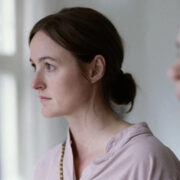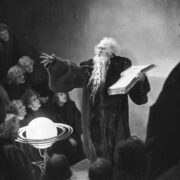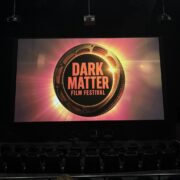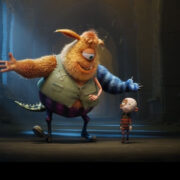Tribeca 2025: DOG OF GOD

Payton McCarty-Simas is a freelance writer and artist based in…
Fans of midnight madness should look no further than Dog of God, one of the most highly anticipated attractions for genre aficionados at this year’s Escape from Tribeca. This psychedelic, rotoscope-animated folk horror freakout out of Latvia boasts werewolves, witches, magic mushrooms, and orgiastic nightcrawling replete with supersized snakelike members and oozing plague sores–– all set to a throbbing techno-metal score (by Lauris Ābele) that, at times, evokes the grinding opening bars of Nine Inch Nails’ “Closer.” Sibling directing duo Lauris and Raitis Ābele have conjured up a visually scrumptious 17th century trip somewhere between Witchfinder General and Mandy. It’s not to be missed.
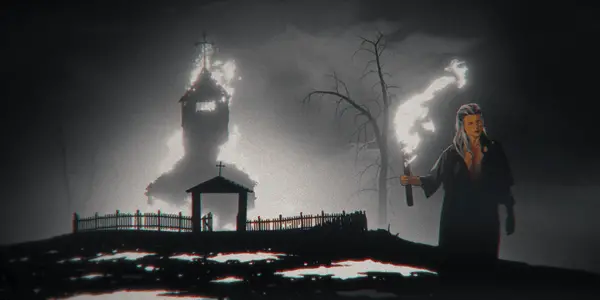
Like its fellow Latvian feature Flow (which won this year’s Best Animated Feature Oscar), Dog of God’s animation is a delight to behold. Swathed in a chilly, autumnal haze, the Livonian village of Zaube is a darkly magical place; its decay is marked by the slow rotting of a mutant dog with a man’s face twisted into an expression of mild shock (an apt comparison, for more reasons than one, may be Jerry Garcia’s grotesque cameo in Philip Kaufman’s Invasion of the Body Snatchers). The story is darkly biblical, presented as a loose reimagination of the story of Moses by a cold open featuring a shamanic werewolf (Einars Repše) rising from the grave and parting the sea.
From there, we meet the morally decadent townsfolk of Zaube: An egomaniacal Pastor Bukholcs (Regnārs Vaivars) and his foundling thrall, the cruelly named “Kiblis,” or “Cripple” (Jurġis Spulenieks) berate the townsfolk for passing zombielike hours in the local tavern run by the beautiful Nēze (Agate Krista), who the Pastor believes to be a witch. The impotent Baron (Kristians Karelins) and his German bride (Madara Madi), who he feeds to painful excess in lieu of the “sexy time” he so desperately seeks, assures Bukholcs that his belief in witchcraft is an outdated superstition, out of step with the laws of the land. Of course, that doesn’t stop the lustful Pastor from pursuing his witch hunt with a passion. Nēze, for her part, practices psychedelic herbalism for hire, summoning the slimiest denizens of the town’s swampy mire to her tavern to secrete the potent substances she uses to treat the plague-striken in washes of hazy, muddy, rainbow colors.
Needless to say, the village descends into the kind of godless decadence readers of Georges Batailles‘ Story of the Eye and Ottessa Moshfegh’s Lapvona (the former of which is directly referenced in one arresting anatomical impossibility near the film’s conclusion, the latter of which happily plays in the same manure-filled sandbox) will find satisfyingly familiar.

Further plot description for this film would be utterly beside the point; its broad strokes are hewn from a classic tradition of Medieval madness and monstrosity. It’s the telling that’s the treat, and treat it is. Marcis Ābele’s hallucinatory cinematography and Harijs Grunmanis and Aigars Gercans’ animation are beautifully matched, creating deep focus frames notable for their breathtaking play with light and atmospheric sense of perennial, unfocused dread. The psychedelic sequences are fantastic–– if not quite as virtuosic as those in Belladonna of Sadness, perhaps the gold standard of experimental animated witch films, though this may be an unfairly high (read: nerdy) metric. These sequences, for their part, are fresh, incorporating unexpected non-Christian imagery and bringing the film’s play with light to new levels.
Leaving the press screening, I spoke with a fellow critic who suggested this film might be divisive with audiences. I personally suspect that if you’ve read this far, though, Dog of God is probably for you. Sin and devotion are two sides of the same coin, the Dog of God reminds the pastor. Horror fans know this best of all.
Does content like this matter to you?
Become a Member and support film journalism. Unlock access to all of Film Inquiry`s great articles. Join a community of like-minded readers who are passionate about cinema - get access to our private members Network, give back to independent filmmakers, and more.
Payton McCarty-Simas is a freelance writer and artist based in New York City. They grew up in Massachusetts devouring Stephen King novels, Edgar Allan Poe stories, and Scooby Doo on VHS. Payton holds a masters degree in film and media studies from Columbia University and her work focuses on horror film, psychedelia, and the occult in particular. Their first book, One Step Short of Crazy: National Treasure and the Landscape of American Conspiracy Culture, is due for release in November.


